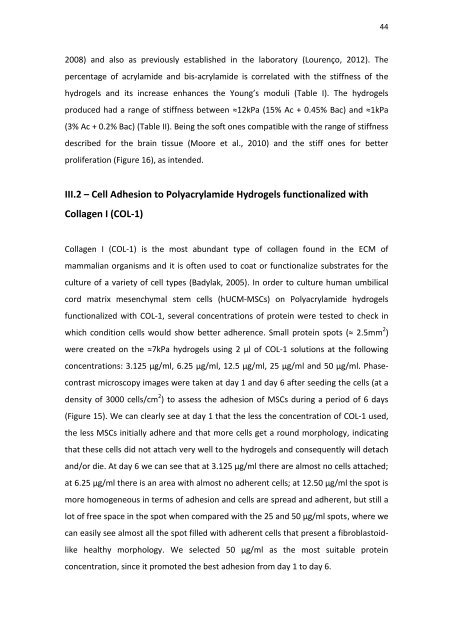DEPARTAMENTO DE CIÊNCIAS DA VIDA ... - Estudo Geral
DEPARTAMENTO DE CIÊNCIAS DA VIDA ... - Estudo Geral
DEPARTAMENTO DE CIÊNCIAS DA VIDA ... - Estudo Geral
You also want an ePaper? Increase the reach of your titles
YUMPU automatically turns print PDFs into web optimized ePapers that Google loves.
44<br />
2008) and also as previously established in the laboratory (Lourenço, 2012). The<br />
percentage of acrylamide and bis-acrylamide is correlated with the stiffness of the<br />
hydrogels and its increase enhances the Young’s moduli (Table I). The hydrogels<br />
produced had a range of stiffness between ≈12kPa (15% Ac + 0.45% Bac) and ≈1kPa<br />
(3% Ac + 0.2% Bac) (Table II). Being the soft ones compatible with the range of stiffness<br />
described for the brain tissue (Moore et al., 2010) and the stiff ones for better<br />
proliferation (Figure 16), as intended.<br />
III.2 – Cell Adhesion to Polyacrylamide Hydrogels functionalized with<br />
Collagen I (COL-1)<br />
Collagen I (COL-1) is the most abundant type of collagen found in the ECM of<br />
mammalian organisms and it is often used to coat or functionalize substrates for the<br />
culture of a variety of cell types (Badylak, 2005). In order to culture human umbilical<br />
cord matrix mesenchymal stem cells (hUCM-MSCs) on Polyacrylamide hydrogels<br />
functionalized with COL-1, several concentrations of protein were tested to check in<br />
which condition cells would show better adherence. Small protein spots (≈ 2.5mm 2 )<br />
were created on the ≈7kPa hydrogels using 2 µl of COL-1 solutions at the following<br />
concentrations: 3.125 µg/ml, 6.25 µg/ml, 12.5 µg/ml, 25 µg/ml and 50 µg/ml. Phasecontrast<br />
microscopy images were taken at day 1 and day 6 after seeding the cells (at a<br />
density of 3000 cells/cm 2 ) to assess the adhesion of MSCs during a period of 6 days<br />
(Figure 15). We can clearly see at day 1 that the less the concentration of COL-1 used,<br />
the less MSCs initially adhere and that more cells get a round morphology, indicating<br />
that these cells did not attach very well to the hydrogels and consequently will detach<br />
and/or die. At day 6 we can see that at 3.125 µg/ml there are almost no cells attached;<br />
at 6.25 µg/ml there is an area with almost no adherent cells; at 12.50 µg/ml the spot is<br />
more homogeneous in terms of adhesion and cells are spread and adherent, but still a<br />
lot of free space in the spot when compared with the 25 and 50 µg/ml spots, where we<br />
can easily see almost all the spot filled with adherent cells that present a fibroblastoidlike<br />
healthy morphology. We selected 50 µg/ml as the most suitable protein<br />
concentration, since it promoted the best adhesion from day 1 to day 6.
















